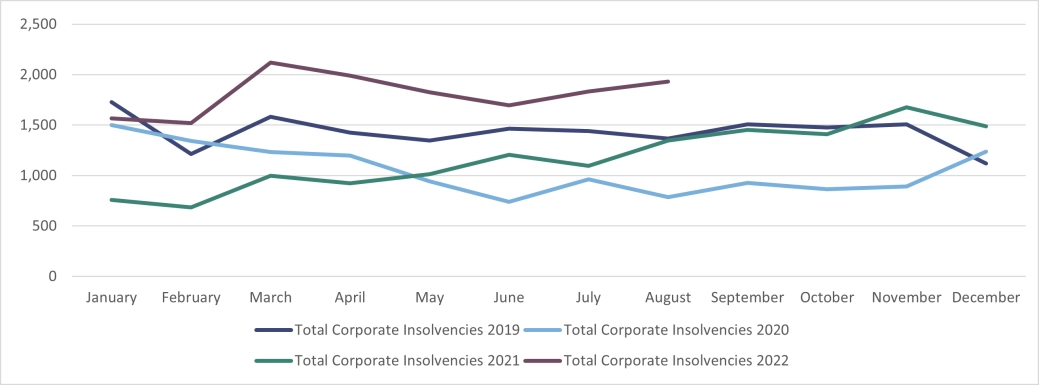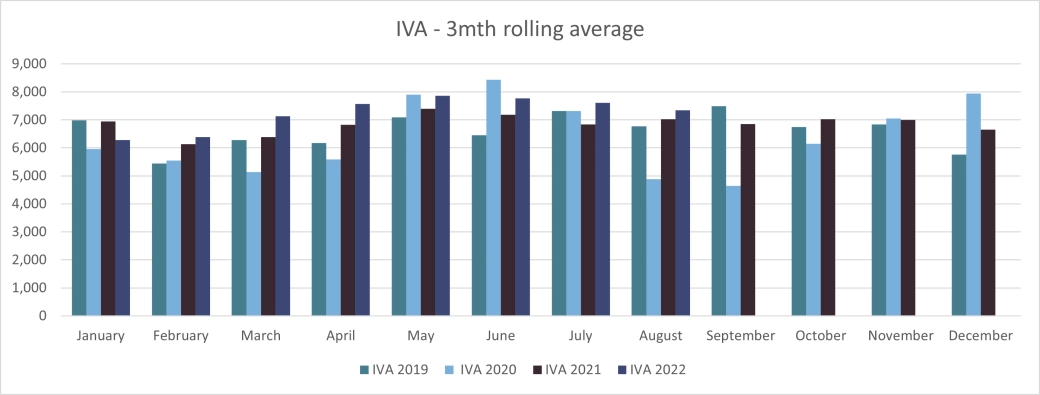
Monthly insolvency statistics – August 2022
Monthly insolvency statistics – August 2022
Corporate Insolvencies
Total corporate insolvencies in August 2022 were 1,993. This is 43% greater than August 2021 and importantly 42% higher than August 2019 (pre COVID pandemic). The August figures were driven by the number of Creditors Voluntary Liquidations.
England and Wales
Creditors Voluntary Liquidations (“CVLs”) totalled 1,662 and were 33% higher than August 2021 and 73% higher than in (pre-pandemic) August 2019.
It is notable that CVLs are significantly higher than in August 2019 as a pre pandemic comparison. Whilst August can sometimes be a time of less insolvency activity, the data may reflect that CVLs are the most appropriate insolvency procedure. There is likely to be a variety of reasons such as:
- a significant number of small companies unable to continue under the weight of Covid borrowings;
- the current economic headwinds around inflation drive costs increases, or;
- CVLs being the most appropriate insolvency procedure instead of what would otherwise have been an Administration. Administrations are more commonly utilised where there may exist the potential for a sale of the business and assets of the Company to achieve a great realisation than in a liquidation, but the current economic position creates a lack of appetite for such acquisitions.
Compulsory Liquidations (“WUCs”) (142) continue to be lower (27%) than they were pre-pandemic but 3.7 times higher when compared to April 2021.
Administrations totalled 116 which is 111% higher than in August 2021 but 34% lower than pre pandemic levels. The increase in corporate insolvencies continues to be driven by Liquidations.
CVAs (13) remain at low levels in August 2022, 6.5 times greater than August 2021 but 57% lower than August 2019.
Scotland
In August 2022 there were 105 company insolvencies registered in Scotland, 18% higher than the number in August 2021 and 33% higher than in August 2019. This was comprised of 37 Compulsory Liquidations, 65 CVLs and three Administrations. There were no CVAs or Receivership appointments.
Northern Ireland
In August 2022 there were 14 company insolvencies registered in Northern Ireland, a 56% increase on August 2021 but 36% less than August 2019. This is comprised of 10 CVLs, 2 Compulsory Liquidations, 1 Administration and 1 CVA.
Personal Insolvencies
England and Wales
Personal insolvency numbers continue to remain flat and show no real signs of increasing at the same rates as corporate insolvencies, particularly voluntary liquidations, but this cannot be sustained for an indefinite period. With fuel and energy prices still volatile and the cost-of-living crisis taking effect, personal insolvencies are almost certain to rise in the coming months and show a more marked increase into 2023.
It is interesting to see a distinction starting to develop between the frequency of use of the different personal insolvency solutions available to address problems of indebtedness.
For example, we can see that Breathing Space (BS) applications have hovered around 5,400 per month since inception, and August saw another upturn in 6,058 applications being made.
88 Mental Health BS applications were made in August, against a similar monthly average, and 5,971 Standard BS applications were made, against an average of 5,345.
Those using BS, may well be people with more pressing and immediate debts that elicit creditor pressure quickly, such as rent and mortgage arrears.
There has been a 12-month average of 7,120 Individual Voluntary Arrangements (IVA’s) in the year to July and then 7,340 recorded in August, but IVA’s have fluctuated between around 6,300 and 7,800 per month for some time and August may just represent one of the many minor peaks, rather than the beginning of a more permanent upward trend.
Following the changes in criteria from June 2021, allowing easier entry into a Debt Relief Order (DRO), they have averaged around 2,005 per month, with the August figure of 1,932 representing a very slight reduction.
A “new” DRO would have previously been a bankruptcy and therefore, the DRO and bankruptcy graphs travelling in diverging directions is no real surprise. In August, there were only 565 bankruptcies, against a 12-month average of 584.
Bankruptcies are at historical lows and the flat trend in debtors making their own bankruptcy application in August (491 against a 12-month average of 495) is a result of those who are now eligible to choose a DRO instead.
However, bankruptcy petitions will undoubtedly have to be issued to recover debts incurred during the pandemic and as a result of current economic pressures. We do expect to see creditor-driven bankruptcies begin to increase into 2023. However, in August there were only 74 creditors’ petitions, which is down on the 12-month average of 89.
One noticeable element to the creditor petition statistics is that HMRC have now crept to the top of the table of volume bankruptcy petitioners, which reflects the government’s intentions in relation to recovery of unpaid tax. Although corporate entities who are engaging with HMRC appear to be obtaining generous time to pay arrangements, individuals who are not engaging appear to be facing no nonsense enforcement.
Northern Ireland
In August 2022 there were 125 individual insolvencies in Northern Ireland, 16% lower than in August 2021, but 39% lower than August 2019. This consisted of 111 IVAs, 10 DROs and four bankruptcies.


















